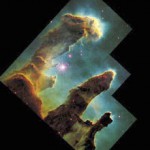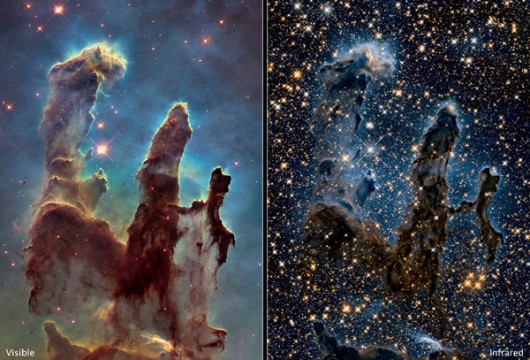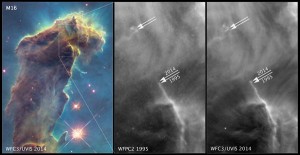The Hubble Space Telescope is commemorating its 25th anniversary with a second look at the Pillars of Creation — but there’s hard science behind these pretty pictures.

In 1995, astronomers released what is now an iconic image of M16, an open star cluster and nebulous region sculpted by stellar winds and radiation. Also known as the Eagle Nebula, the star-forming region sits 6,500 light-years away in the constellation Serpens Cauda, stuffed in between Scutum and Ophiuchus about 12° north of the Sagittarius teapot lid.
But Hubble has had a lot of updates since 1995. So astronomers took a second look at the Eagle Nebula, this time through both visible-light and near-infrared filters with the space telescope’s Wide Field Camera 3, which in 2009 replaced the Wide Field and Planetary Camera 2 that took the original composite image. The results appear below.

NASA / ESA / Hubble Heritage Team (STScI / AURA)
Like the 1995 version, the new visible-light composite image is color-coded not for realism but for physics. The colors reveal the chemical composition of various parts of the nebula: blue is doubly ionized oxygen, green is ionized hydrogen, and reddish-orange is ionized sulfur. Along with the infrared view, the chemical makeup reveals the gas density in different parts of the region and also how energetic the photons are (it takes a lot of energy to rip two electrons off an oxygen atom, which is why the cavity around the young, intense stars is blue — the stars are above the region pictured).
The infrared composite view — which I personally think is the most beautiful of the bunch — bypasses all but the densest dusty gas, making it look like the gas has disappeared. The infrared image also makes more obvious why the pillars exist in the first place: they’re actually gas that’s hiding in the “shadow” of dense clouds at the pillars’ tops, which are shielding the gas from the stars’ destructive ultraviolet radiation and stellar winds. In effect, the stars are pouring down stellar acidic rain that’s eroding any gas it can reach; only the material shielded by the cloud umbrellas is safe.

NASA / ESA / Hubble Heritage Team (STScI / AURA)
Both these images and the original observations from 1995 gave astronomers a much-desired look at what happens at the edge of the cavity surrounding these HII regions (so called because the hydrogen is ionized by the newly born stars). Astronomers estimate that it’s taken a few hundred thousand to a few million years to wipe out the gas between the pillars, which is about the same length of time the hottest, most massive stars spend fusing hydrogen in their cores.
The new view has twice the resolution and peers roughly 10 times as deep as the old one in the same exposure time. The pillars’ edges were sharp at the limit of the 1995 resolution; surprisingly, in the new observations they’re still sharp, meaning that it only takes 100 Earth-Sun distances to transition from being inside the pillar to outside. In comparison, the pillars are about 5 light-years tall, or 3,160 times bigger.
The infrared observations also enable astronomers to peer inside little nodules on the pillars, inside which stars should be growing. In the 1995 image, astronomers found about 60 to 70 nodules; in the infrared, only 5 to 10 of those in fact have infrared sources at their hearts, meaning that star formation in this environment has only a 10% success rate. That’s because instead of a secondary stellar nativity in the cavity wall, which would be spurred when forming stars compressed the wall’s gas, the radiation and stellar winds are excavating the little globules before they’ve finished collapsing. Essentially, the poor things needed more time in the oven and didn't get it.
You can read more about the images in the Hubble press release. And many amateur astrophotographers have created gorgeous images of M16. Check them out in our online gallery.
 4
4
Comments
Peter Wilson
January 11, 2015 at 1:26 pm
"In comparison, the pillars are about 5,000 light-years tall..."
Should that be 5 light-years tall?
You must be logged in to post a comment.
January 12, 2015 at 1:08 am
You are right Pete. It's about 4-5 Light years in length and about 7.0 mly away.
You must be logged in to post a comment.
Frank-ReedNavigation.com
January 12, 2015 at 4:03 am
And the comparison factor "316,000,000" appears to be a little error, too. That number is the number of AUs in 5000 lightyears. But if the real height of the pillars is 5 ly (not 5,000) and the edge thickness is actually 100 AU (not 1 AU), then the factor would be reduced by 100,000... so that leaves 3,160. That is, the transition "edge" is about 3000 times smaller than the height of the "pillars". Is that right?
You must be logged in to post a comment.
Camille M. CarlislePost Author
January 12, 2015 at 12:59 pm
Re: 5 vs. 5,000 light-years -- Gah, I don't know what I was thinking. Thanks readers for keeping me honest!
You must be logged in to post a comment.
You must be logged in to post a comment.